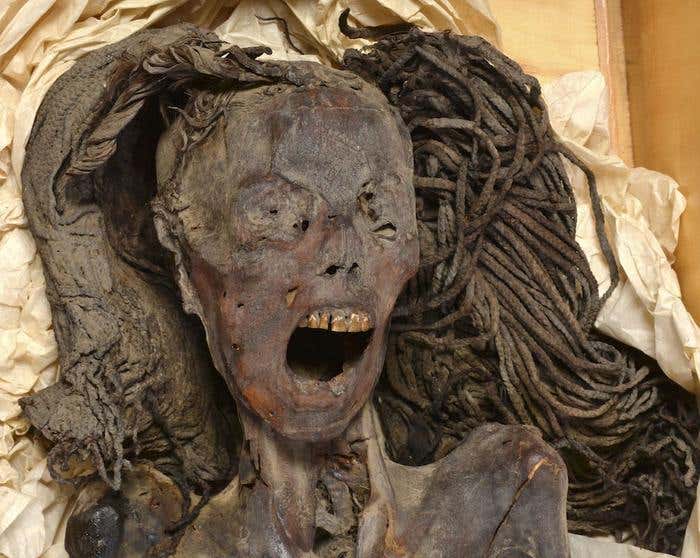Famous mummy expression may be due to agony, not poor embalming
Egyptian woman was embalmed with costly imported ingredients, suggesting her expression was caused by pain, not poor embalming

The Screaming Woman mummy (CREDIT: Sahar Saleem)
In 1935, the Metropolitan Museum of New York embarked on an archaeological expedition to Egypt. Near Luxor, in the area known as Deir Elbahari, they uncovered the tomb of Senmut, a notable figure from ancient Thebes.
Senmut, an architect and overseer of royal works, was closely associated with Queen Hatshepsut, who ruled from 1479 to 1458 BCE. Beneath his tomb, the team discovered a separate burial chamber believed to house the remains of his mother, Hat-Nufer, along with other unidentified relatives.
Within this chamber, archaeologists made a startling discovery: a wooden coffin containing the mummy of an elderly woman. This woman, adorned with a black wig and two scarab rings made of silver and gold, became known as the ‘Screaming Woman.’ What set this mummy apart was her expression, with her mouth wide open, seemingly frozen in a scream. The eerie nature of her appearance intrigued researchers and has continued to captivate scientific inquiry.
Fast forward approximately 2,500 years, and researchers from Egypt have employed advanced scientific techniques to delve deeper into the mystery of the Screaming Woman. Their findings have been published in Frontiers in Medicine, shedding new light on her life and death.
Dr. Sahar Saleem, a professor of radiology at Kasr Al Ainy Hospital of Cairo University, led the investigation. Saleem emphasized the significance of the materials used in the mummification process: “Here we show that she was embalmed with costly, imported embalming material. This, and the mummy's well-preserved appearance, contradicts the traditional belief that a failure to remove her inner organs implied poor mummification,” she explained.
Before being moved to the Cairo Egyptian Museum, the Screaming Woman had been housed at the Kasr Al Ainy School of Medicine in Cairo. During the 1920s and 1930s, many royal mummies, including that of Tutankhamun, were studied there. Since 1935, the Screaming Woman's coffin and rings have been on display at the Metropolitan Museum of New York.
In the new study, Saleem used CT scans to conduct a ‘virtual dissection’ of the mummy. These scans allowed researchers to estimate her age, identify any health conditions, and assess her state of preservation. Additionally, advanced techniques such as scanning electron microscopy (SEM), Fourier transform infrared spectroscopy (FTIR), and x-ray diffraction analysis (XRD) were utilized to examine the materials used in her embalming.
Related Stories
Despite being buried for over two millennia, the Screaming Woman’s condition remained remarkably well-preserved. The investigation, conducted 89 years after her initial discovery, revealed that she was unwrapped, lying on her back with her legs extended and her hands folded above her groin.
Several of her teeth were missing, likely lost before death, as evidence of bone resorption—a process that occurs when a tooth is lost and the socket heals—was found. Other teeth were broken or showed signs of wear.
“Teeth lost during life may have been extracted. Dentistry had originated in ancient Egypt, with Hesy Re the first recorded physician and dentist in the world,” noted Saleem, highlighting the advanced state of dental knowledge in ancient Egypt.
Using 2D and 3D CT images, Saleem estimated that the Screaming Woman stood about 1.54 meters tall in life. The condition of her pelvic bones, which smoothen with age, suggested she was around 48 years old when she died. Evidence of mild arthritis in her spine was also found, indicated by the presence of osteophytes, or bone spurs, on her vertebrae.
Interestingly, there was no sign of an embalming incision, and her internal organs, including the brain, diaphragm, heart, lungs, liver, spleen, kidneys, and intestines, were still intact. This finding was surprising, as the traditional mummification method during the New Kingdom (1550–1069 BCE) typically involved the removal of most internal organs, with the heart being the only one left in place.
Further analysis of her skin through FTIR revealed that the Screaming Woman had been embalmed with costly materials like juniper and frankincense. These substances were not native to Egypt and had to be imported from the Eastern Mediterranean, East Africa, or Southern Arabia.
Her natural hair had been dyed with henna and juniper, while her long wig, made from fibers of the date palm, had been treated with quartz, magnetite, and albite crystals. These treatments likely served to stiffen the wig and give it the black color, which was highly valued in ancient Egypt for its association with youth.
“These findings support the ancient trade of embalming materials in ancient Egypt. The expedition led by Queen Hatshepsut brought frankincense from Punt (possibly Somalia in Africa). The tomb of Tutankhamun also contained frankincense and juniper,” Saleem pointed out, underscoring the significance of trade in these valuable resources.
Despite extensive analysis, the cause of the Screaming Woman’s death remains a mystery. However, her haunting expression has sparked much speculation. Saleem proposed a possible explanation: “The mummy's screaming facial expression in this study could be read as a cadaveric spasm, implying that the woman died screaming from agony or pain.”
Cadaveric spasm is a rare form of muscular stiffening, usually associated with violent deaths under extreme physical conditions and intense emotion. This phenomenon might explain the terrifying expression that has so intrigued those who have studied her.
In the end, the Screaming Woman serves as a “time capsule” of ancient Egypt, preserving not only her physical form but also a glimpse into the circumstances of her death and the rituals that followed. Her story continues to unfold, offering new insights into the lives and deaths of those who lived thousands of years ago.
Note: Materials provided above by The Brighter Side of News. Content may be edited for style and length.
Like these kind of feel good stories? Get The Brighter Side of News' newsletter.
Joshua Shavit
Science & Technology Writer | AI and Robotics Reporter
Joshua Shavit is a Los Angeles-based science and technology writer with a passion for exploring the breakthroughs shaping the future. As a contributor to The Brighter Side of News, he focuses on positive and transformative advancements in AI, technology, physics, engineering, robotics and space science. Joshua is currently working towards a Bachelor of Science in Business Administration at the University of California, Berkeley. He combines his academic background with a talent for storytelling, making complex scientific discoveries engaging and accessible. His work highlights the innovators behind the ideas, bringing readers closer to the people driving progress.



